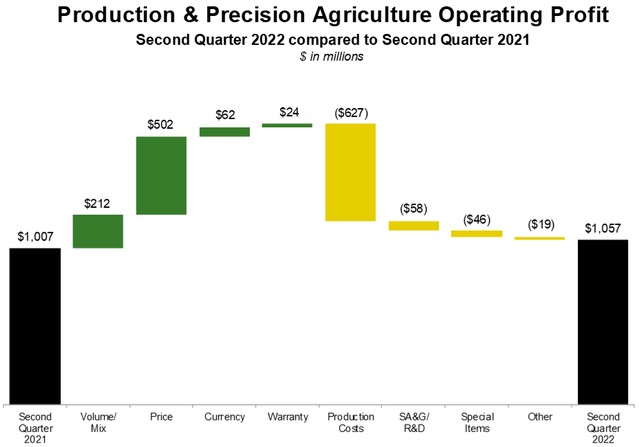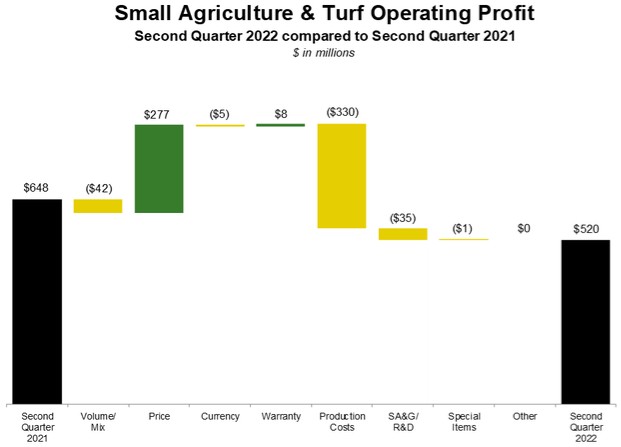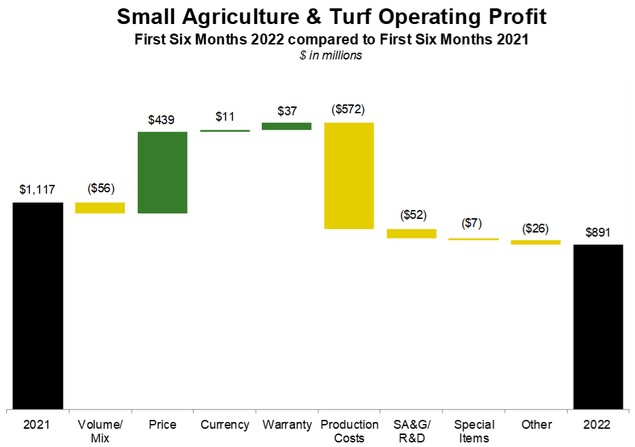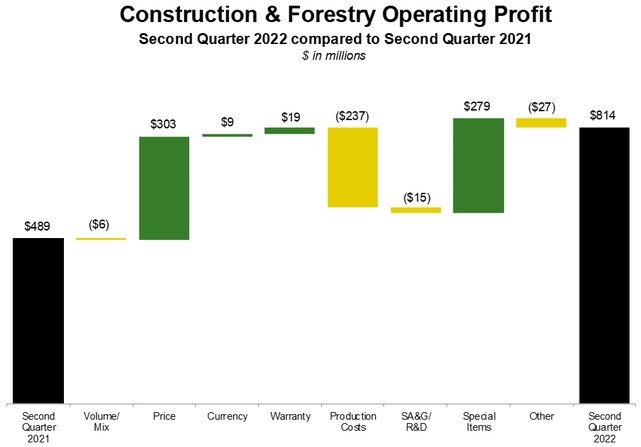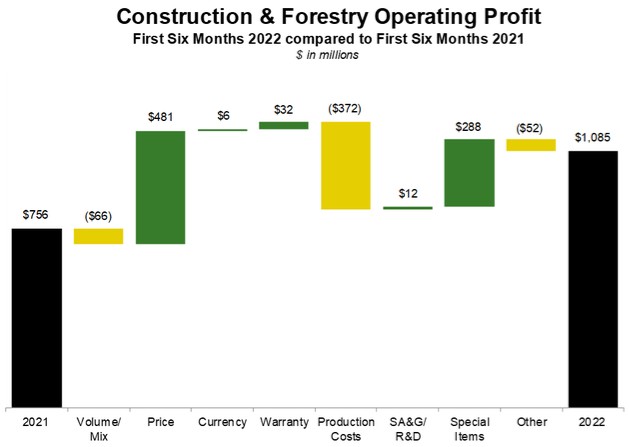in borrowings of $676 million, and dividends paid of $480 million. Cash, cash equivalents, and restricted cash increased $138 million in the first six months of 2021.
Trade receivables held by the equipment operations increased $203 million during the first six months of 2022 and increased $133 million from a year ago. The equipment operations sell a significant portion of their trade receivables to financial services. See the previous consolidated discussion of trade receivables.
Inventories increased by $2,249 million during the first six months of 2022 and increased by $2,988 million compared to a year ago. The higher levels in both periods are due to increased overall demand and the impact of supply chain disruptions, partially offset by foreign currency translation. A majority of these inventories are valued on the last-in, first-out (LIFO) method.
Total interest-bearing debt, excluding finance lease liabilities, of the equipment operations was $10,057 million at May 1, 2022, compared with $10,373 million at October 31, 2021 and $10,421 million at May 2, 2021. The ratios of debt to total capital (total interest-bearing debt and Deere & Company’s stockholders’ equity) were 35 percent, 36 percent, and 41 percent at May 1, 2022, October 31, 2021, and May 2, 2021, respectively.
Property and equipment cash expenditures for the equipment operations in the first six months of 2022 were $345 million, compared with $319 million in the same period last year. Capital expenditures for the equipment operations in 2022 are estimated to be approximately $1,175 million.
Financial Services
The financial services operations rely on their ability to raise substantial amounts of funds to finance their receivable and lease portfolios. Their primary sources of funds for this purpose are a combination of commercial paper, term debt, securitization of retail notes, equity capital, and borrowings from Deere & Company.
During the first six months of 2022 and 2021, the cash provided by operating and financing activities was used for investing activities. Cash, cash equivalents, and restricted cash decreased $128 million in the first six months of 2022 and decreased $29 million in the first six months of 2021.
Receivables and leases held by the financial services operations consist of retail notes originated in connection with financing of new and used equipment, operating leases, trade receivables, revolving charge accounts, sales-type and direct financing leases, and wholesale notes. Trade and financing receivables and equipment on operating leases increased $1,389 million during the first six months of 2022 and increased $2,330 million in the past 12 months primarily due to higher sales. Total acquisition volumes of receivables (excluding trade and wholesale) and leases were 1 percent higher in the first six months of 2022, compared with the same period last year, as volumes of revolving charge accounts were higher, while volumes of retail notes, financing leases, and operating leases were lower. The amount of total trade receivables and wholesale notes increased compared to October 31, 2021 and decreased compared to May 2, 2021.
Total external interest-bearing debt of the financial services operations was $38,751 million at May 1, 2022, compared with $37,978 million at October 31, 2021 and $36,873 million at May 2, 2021. Total external borrowings have changed generally corresponding with the level of receivable and lease portfolio, the level of cash and cash equivalents, the change in payables owed to Deere & Company, and the change in investment from Deere & Company. The financial services operations’ ratio of interest-bearing debt, including intercompany debt, to stockholder’s equity was 7.8 to 1 at May 1, 2022, compared with 7.8 to 1 at October 31, 2021 and 7.7 to 1 at May 2, 2021. The long-term portion of payables due to Deere & Company was $716 million at May 1, 2022 and $584 million at October 31, 2021.
Capital Corporation has a revolving warehouse facility to utilize bank conduit facilities to securitize retail notes (see Note 9). The facility was renewed in November 2021 with an expiration in November 2022 and a reduction of the total capacity or “financing limit” from $2,000 million to $1,000 million. As a result of the reduced capacity, Capital Corporation repurchased $511 million of outstanding short-term securitization borrowings in November 2021, in addition to the normal payments collected on the retail notes. At May 1, 2022, $760 million of securitization borrowings was outstanding under the facility. At the end of the contractual revolving period, unless the banks and Capital Corporation agree to renew, Capital Corporation would liquidate the secured borrowings over time as payments on the retail notes are collected.
In the first six months of 2022, the financial services operations issued $1,224 million and retired $1,818 million of retail note securitization borrowings, which are presented in Increase in total short-term borrowings on the statements of consolidated cash flows. In addition, during the first six months of 2022, the financial services operations issued $4,243 million and retired $3,317 million of long-term borrowings, which were primarily medium-
